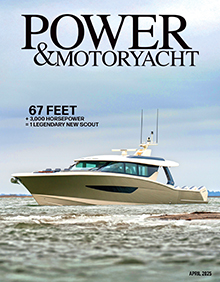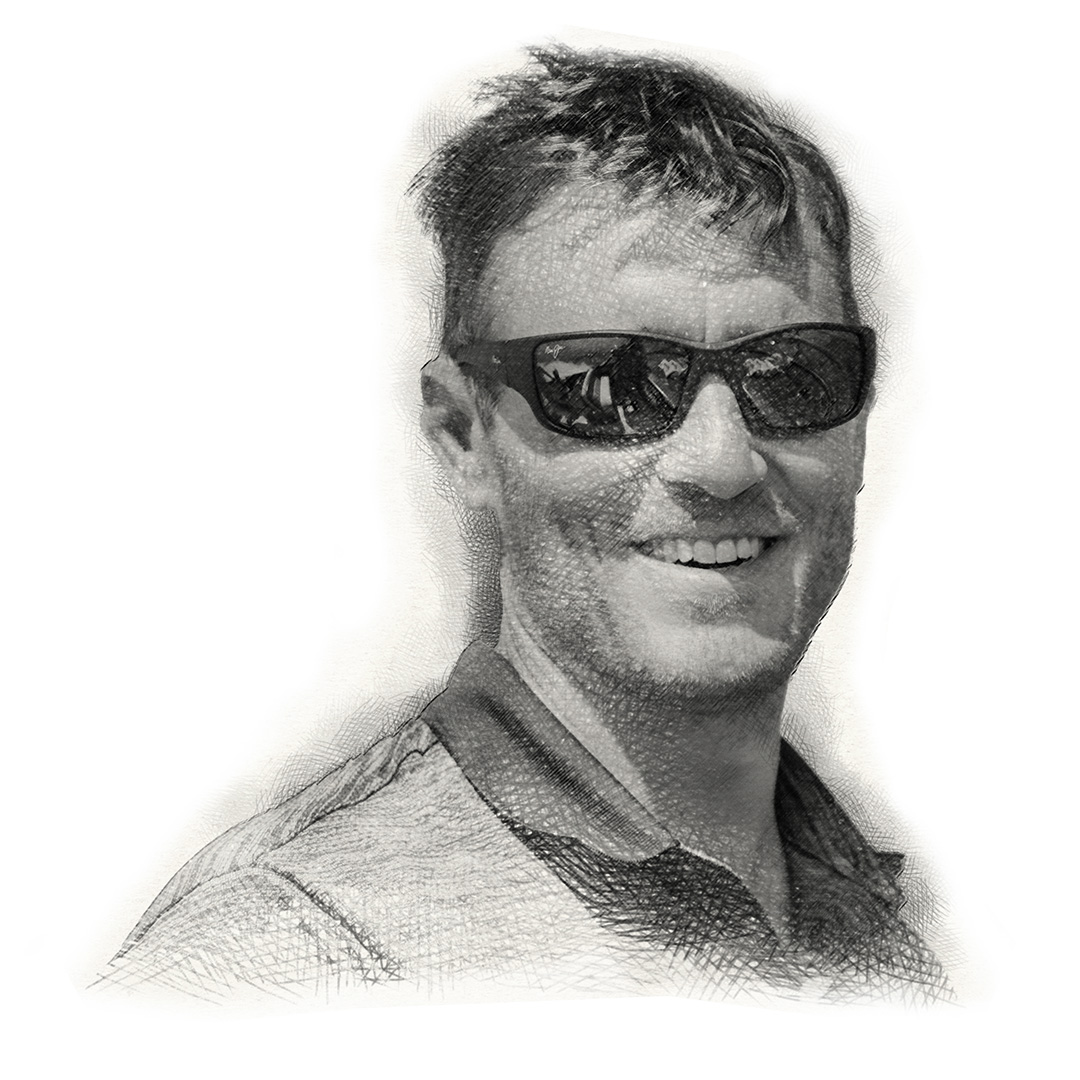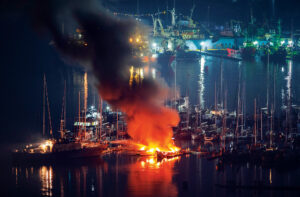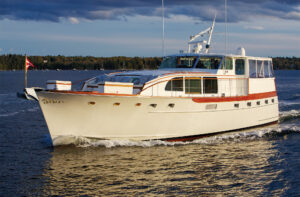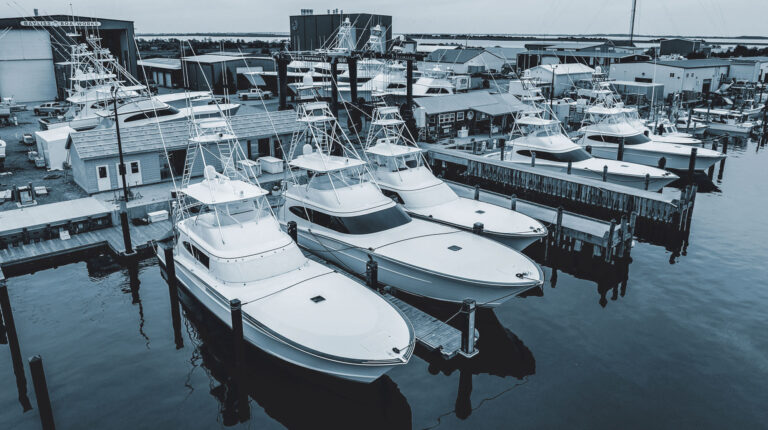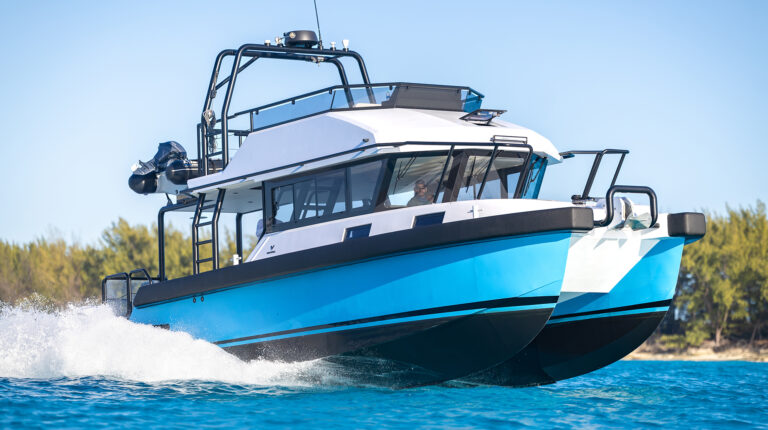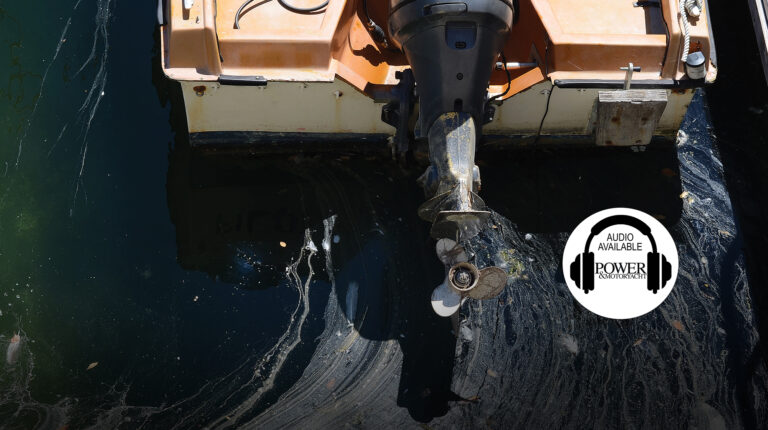A posse of children grabbing the bow rail with white knuckles while the boat lurches into a steep head sea, not a PFD in sight. Pontoon boats and bow riders submarining into waves, pouring a sickening amount of the ocean into the boat, guests being tossed like rag dolls into the air after coming off a crest, people falling overboard or even jumping overboard to rescue a hundred-dollar cushion. Social media feeds from Haulover Inlet have been shining a light on all kinds of bad boating and causing fierce debates about freedom and thrill chasing vs. common sense and seamanship in comments sections. We sit down with the Coast Guard to get an official verdict on these frequently seen bad decisions.
PMY: Why is it that Florida’s Haulover Inlet seems to be a breeding ground for bad boating behavior?
Szcepaniak: First of all, if you spend some time in South Florida, you know it’s sunny. There’s lots of bathing suits and bikinis out there and people are going to Miami and Miami Beach to have a good time. Because of that, perhaps personal safety is not top of mind, but having a good time is.
The most important thing to know about Haulover—and east-facing inlets in general—is that it’s most challenging when there’s a falling tide and an east wind or a wind and swell with an east component. When a tidal current’s going against the waves, it forces the waves to be steep and more dangerous; they’re closer together. And so, one of the best things to do is avoid those kind of waves by waiting until slack tide or an incoming flood tide and then the conditions go away. I’ve been at that inlet and it’s been flat as a pancake, and then the tide starts running out and just like that, the seas start building up.
In other parts of the world with greater tidal flow, they say, when in doubt, wait it out. That certainly applies there. Another layer to that question is: Is your boat seaworthy? A lot of the boats that I see on Wavy Boats and Qualified Captain, and all the different channels that film down there, are bow riders. And in my 40 years of experience, a bow rider’s a great lake boat. It’s not a sea boat; it’s not an ocean boat. And certainly, on a calm day the ocean is a big lake. But again, with the tidal considerations, inlets can be challenging bodies of water. So, if your boat’s not capable and you’re not trained to work in that kind of environment, that’s a good reason to avoid it.
On less extreme days, if your boat is seaworthy and you know what you’re doing, you’re going to want to take some time and study the wave pattern and see that there’s an area of bigger, larger, taller waves and an area of smaller waves. And so, ideally the outgoing traffic is keeping to the right and the incoming traffic’s keeping to the right. Boats are passing port to port. But again, looking for the area of the water without the larger waves is a good strategy. Say I was driving down the road and I see a big pothole; if it’s safe to do so, I steer around it. I don’t go right through it. I don’t know why people would choose to go right through the center.
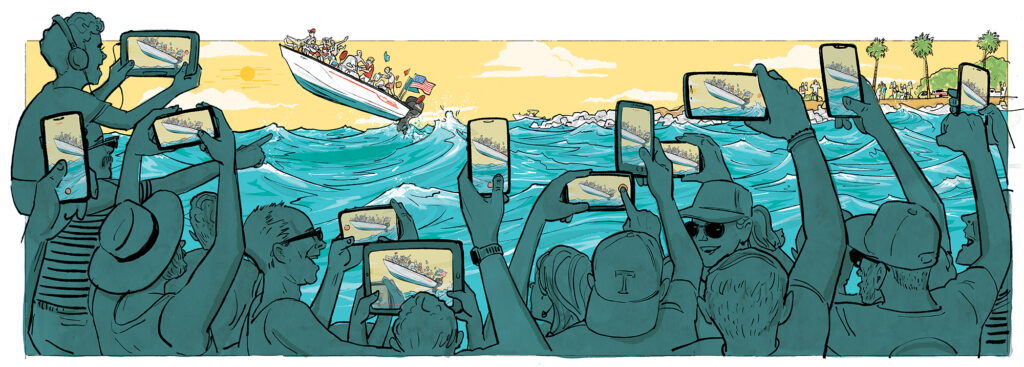
PMY: I want to play dumb for a second and go back to the bow rider question because it’s so prevalent. Why do you feel that bow riders specifically are so dangerous at Haulover?
Szcepaniak: And just so we’re talking on the same terms, when I talk about a bow rider, it’s a smaller recreational boat with the seats on the front that becomes a big water scoop. When you hit a wave and bury the bow like you’ve obviously seen in the videos, the boats that take on water like that, they scoop up a wave or two, they become inherently less stable and more tippy, to the point that the operator panics and turns at the worst possible time, right in the thick of it, and now the wave energy is impacting the boat and rolls it over. So again, a great boat, we love to have people get outside and enjoy our natural environment but a bow rider like that is not designed for ocean waves.
PMY: Can you touch on that a little more, I see a lot of videos where boaters realize they’re in over their heads (sometimes literally) and they turn for home at the worst possible moment.
Szcepaniak: Well, the human instinct is to go explore, and we often don’t know what we don’t know. They often realize pretty quickly when they’re there in the thick of it, but they still don’t know that a panicked turn is a challenging thing to do. I want to encourage everyone to not get themselves into that situation. If I go on using the highway analogy again, if I see flashing lights up ahead, if I see a fog bank up ahead, if I see a rainstorm up ahead, I start to slow down and become really attuned to my situation. I educate myself ahead of time; if I go somewhere new, I’m studying the chart the night before, I’m doing some Internet research, so I’m aware of what to expect.
PMY: The next situation I want to talk about is seeing guests and especially children sitting on the bow while a boat is going through the inlet. Can you talk about the dangers of that?
Szcepaniak: Sure. And not to confuse terms, but we often call that bow riding as well. Whatever kind of boat you’re on, this happens when your hands are [hopefully, at least] on the railing and your legs are dangling over the bow; not only is that illegal, that’s negligent operation from the federal perspective, from the Coast Guard perspective. So, if a Coast Guard officer saw that at the very least, they will issue a warning or write a ticket for negligent operation up to $5,000. But whether it’s legal or illegal I think is less important than the fact that it’s just downright dumb. And again, we all know cars, so imagine taking your two little kids to the supermarket. You’ve installed a little rail on the front of the hood of your little pickup truck or your car, and they’re sitting with their legs dangling down over the front of it. You’d never do it.
Well it’s the same thing on a boat. You hit a wave a little too hard, the kid or the adult slips and down they go, and now they’re struck by the boat and perhaps run over by the propeller. Those propeller injuries when someone falls off the boat are often fatal. There was a terrible incident in Georgia not too long ago involving a young child, the boat bounced off the sandbar and killed a 6-year-old child, he went flying. And so again, the consequences of bow riding are incredibly extreme and often fatal. And so we just want to encourage everybody not to do it. Sure, it’s fun. We want to play Titanic, we want to have the fresh air in our faces, but it’s just downright dumb.
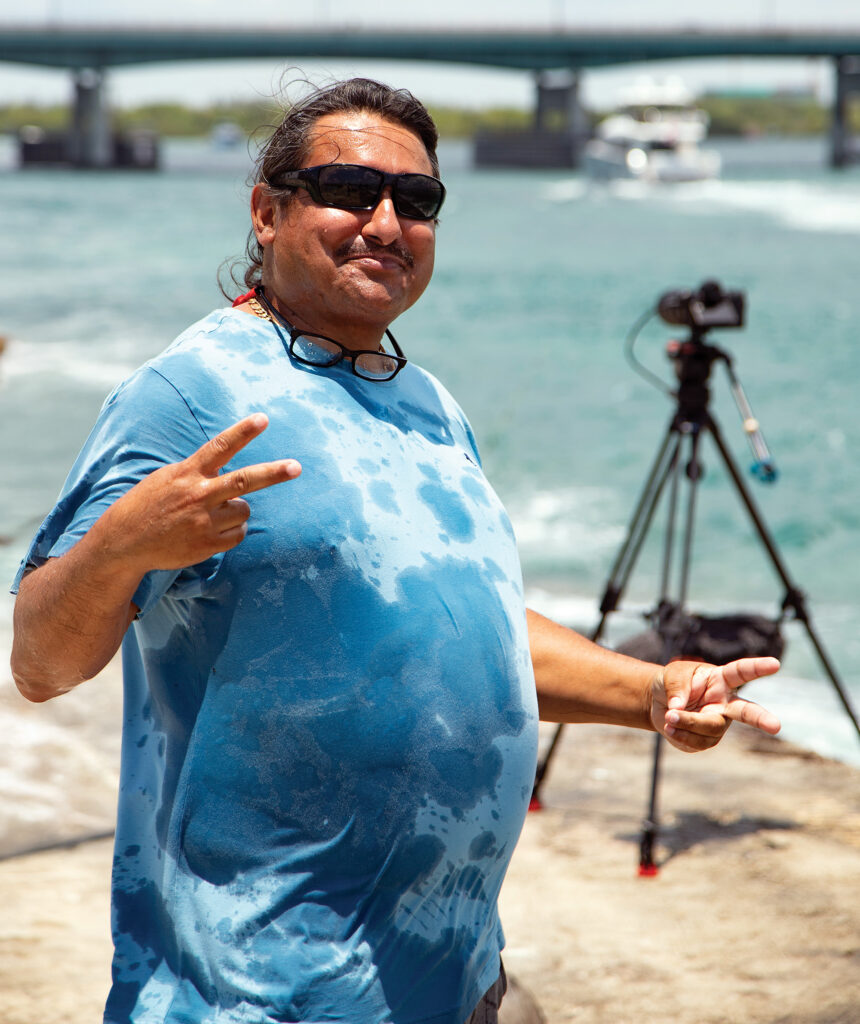
PMY: Another frequent occurrence in viral Haulover videos involves non-fatal but still significant falls when coming off a wave. Can you talk about a captain’s responsibility in those scenarios?
Szcepaniak: When you talk about guests falling, the first thing that comes to mind is let’s have a beer or two, or six, or other hard substances that impact our balance. We generally think that one beer in the maritime environment—with some dehydration, with the vibrations of the boat, the sun—equals about three beers sitting in your living room. We used to talk about designating a sober skipper, and we’ve kind of changed that message because a drunk passenger is more likely to fall overboard, more likely to fall down and get hurt. And again, whether you’re operating the boat or you’re a passenger on the boat, that one beer becomes three beers and the two beers become six beers. So we’d encourage everyone to save their drinking until they get back to the shore and they have a safe Uber ride home. You don’t generally fall out of a taxi cab if you have had a couple too many beers, but you very well might fall off the boat as a passenger with a couple too many beers.
The other thing is that when coming through an inlet, it’s an area where enhanced seamanship comes into play. It requires enhanced awareness, enhanced caution, and if I were running a boat through an inlet, I would make sure everyone was seated in a safe place and that they had one hand on the boat at all times. So again, just some basic seamanship, some caution, some respect for the marine environment, some respect for the ocean.
PMY: What is it about Haulover that seems to encourage such poor decision making, is it the pursuit of social media fame?
Szcepaniak: Well, I think that the longboard surfing community got it right 50 or 60 years ago when they talked about the term Kodak courage. When the surfers were out in Hawaii and there was a big set, they were being cautious and using their heads, but when the surf magazine team showed up with the telephoto lenses and the video cameras, they would think, ‘Boy I’m going to be on the cover of that magazine, I’m going to be famous,’ and they started using less common sense and started getting hurt. I think it’s just human nature. My guests would say, hey, I’ve heard about Haulover, let’s poke our noses out there, and if it was the right day and I had the right boat and I checked the weather and I wasn’t expecting an afternoon thunderstorm and everything lined up, there’s no reason not to slide out there.
But if there’s heavy traffic, thunderstorms are coming in, or the tide’s falling and there’s an eastern component to the wind and the waves big, I say, “Sorry gang, it looks fun on Instagram, but everything we see on social media isn’t really as it seems; that’s a hazardous situation.” The big takeaway is that recreational boaters often don’t know what they don’t know, and education is key.
PMY: Do you recommend practicing in rougher conditions to build your confidence and experience in confusing seas?
Szcepaniak: In my early twenties, it became clear that boating was going to be a lifelong passion. I was lucky that I had great mentors and I had great training. If you’re going to be putting yourself in potentially compromising situations, you need to work up to that. If you’re going further offshore, you take a class about ditch kits and radio beacons and personal locator beacons and repair kits, and you take a hands-on class about emergency repairs. You’ll learn things like why having wooden plugs tied to each through-hole fitting is a good idea. I recommend learning from the Coast Guard Auxiliary, the U.S. Power Squadron—there’s a number of outlets for classroom training—and that’s a great first step. There’s also a number of outlets for on-the-water training; the National Safe Boating Council certifies instructors for on-water classes. Some insurance companies are learning that if you’re educated, you’re less likely to get into a jam. So they’re offering discounts for boaters with hands-on training.
PMY: Do you have any additional advice for boaters?
Szcepaniak: We were taught as young Coast Guardsmen about painting a boat. We learned that preparation prevents poor paint performance, and that means if you paint over slime, the paint isn’t going to stick. You have to sand it down and you have to put the primer on and then put the topcoat on. The same thing is true with boating. Poor preparation means poor performance on the water. You need to plan your routes and do a little research before you go into an unfamiliar area. You need to check the weather before you go out. We’ve heard the stories of the storm that ‘comes out of nowhere,’ and when we look at the meteorological history, it didn’t come out of nowhere, it was forecasted the day before. And so just checking the weather the morning before you’re venturing out and having a plan B or having the maturity and the common sense to say: Nope, today is not the right day for it. It’s too windy. The waves are going to be too big. We’ve got a squall line expected to come through this afternoon. Maybe that’s the day to take a walk around the dock. Or God forbid, scroll social media.
PMY: Do you have any parting shots of wisdom you want to share with the boating community?
Szcepaniak: Yeah, boy, the hardest, hardest thing in the world is to get people to wear their life jackets in South Florida. Again, bathing suits and bikinis… But if I’m transiting an inlet, my passengers are all wearing inflatable life jackets. And inflatable PFDs are a great option in hot climates; you get to the point where you don’t know you’re even wearing them. But if you’re not being conscientious and having you and your passengers wear them at all times, boy, certainly when transiting an inlet is the time where you’d have your passengers put their life jackets on. Any life jacket that you’re wearing is better than when you’re not wearing one. A lot of causes of death on the water are due to drowning, and if you’re wearing a life jacket, you’re far less likely to drown.
Listen to Dan’s full conversation with the USCG here ▶

